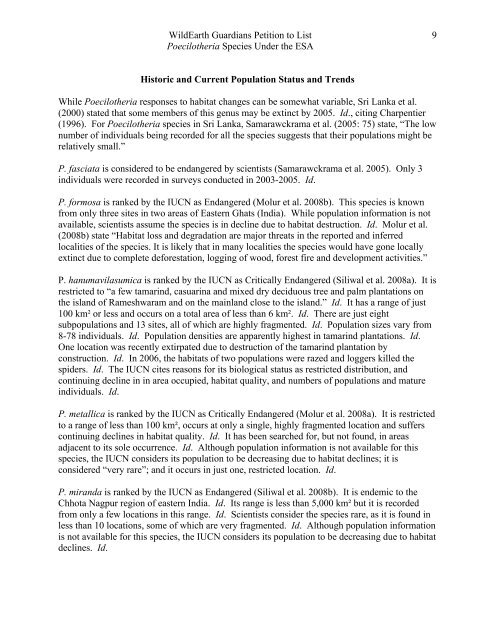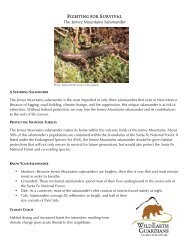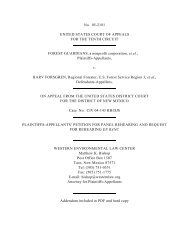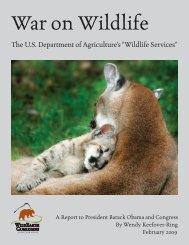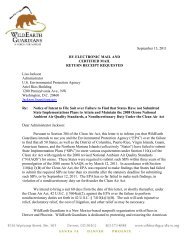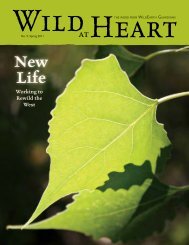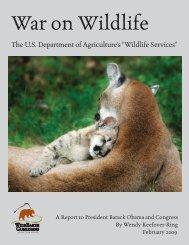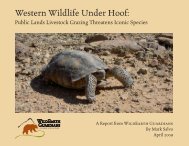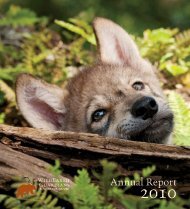Tarantulas Petition - WildEarth Guardians
Tarantulas Petition - WildEarth Guardians
Tarantulas Petition - WildEarth Guardians
Create successful ePaper yourself
Turn your PDF publications into a flip-book with our unique Google optimized e-Paper software.
!<br />
<strong>WildEarth</strong> <strong>Guardians</strong> <strong>Petition</strong> to List<br />
Poecilotheria Species Under the ESA<br />
Historic and Current Population Status and Trends<br />
9!<br />
While Poecilotheria responses to habitat changes can be somewhat variable, Sri Lanka et al.<br />
(2000) stated that some members of this genus may be extinct by 2005. Id., citing Charpentier<br />
(1996). For Poecilotheria species in Sri Lanka, Samarawckrama et al. (2005: 75) state, “The low<br />
number of individuals being recorded for all the species suggests that their populations might be<br />
relatively small.”<br />
P. fasciata is considered to be endangered by scientists (Samarawckrama et al. 2005). Only 3<br />
individuals were recorded in surveys conducted in 2003-2005. Id.<br />
P. formosa is ranked by the IUCN as Endangered (Molur et al. 2008b). This species is known<br />
from only three sites in two areas of Eastern Ghats (India). While population information is not<br />
available, scientists assume the species is in decline due to habitat destruction. Id. Molur et al.<br />
(2008b) state “Habitat loss and degradation are major threats in the reported and inferred<br />
localities of the species. It is likely that in many localities the species would have gone locally<br />
extinct due to complete deforestation, logging of wood, forest fire and development activities.”<br />
P. hanumavilasumica is ranked by the IUCN as Critically Endangered (Siliwal et al. 2008a). It is<br />
restricted to “a few tamarind, casuarina and mixed dry deciduous tree and palm plantations on<br />
the island of Rameshwaram and on the mainland close to the island.” Id. It has a range of just<br />
100 km! or less and occurs on a total area of less than 6 km!. Id. There are just eight<br />
subpopulations and 13 sites, all of which are highly fragmented. Id. Population sizes vary from<br />
8-78 individuals. Id. Population densities are apparently highest in tamarind plantations. Id.<br />
One location was recently extirpated due to destruction of the tamarind plantation by<br />
construction. Id. In 2006, the habitats of two populations were razed and loggers killed the<br />
spiders. Id. The IUCN cites reasons for its biological status as restricted distribution, and<br />
continuing decline in in area occupied, habitat quality, and numbers of populations and mature<br />
individuals. Id.<br />
P. metallica is ranked by the IUCN as Critically Endangered (Molur et al. 2008a). It is restricted<br />
to a range of less than 100 km!, occurs at only a single, highly fragmented location and suffers<br />
continuing declines in habitat quality. Id. It has been searched for, but not found, in areas<br />
adjacent to its sole occurrence. Id. Although population information is not available for this<br />
species, the IUCN considers its population to be decreasing due to habitat declines; it is<br />
considered “very rare”; and it occurs in just one, restricted location. Id.<br />
P. miranda is ranked by the IUCN as Endangered (Siliwal et al. 2008b). It is endemic to the<br />
Chhota Nagpur region of eastern India. Id. Its range is less than 5,000 km! but it is recorded<br />
from only a few locations in this range. Id. Scientists consider the species rare, as it is found in<br />
less than 10 locations, some of which are very fragmented. Id. Although population information<br />
is not available for this species, the IUCN considers its population to be decreasing due to habitat<br />
declines. Id.<br />
! ! !<br />
!


